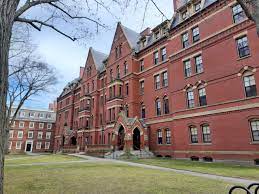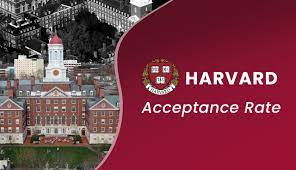Harvard University Acceptance Rate, Harvard University, with its storied history and world-class reputation, stands as one of the most prestigious institutions of higher education globally. Each year, countless students dream of walking through the gates of Harvard Yard, eager to join the ranks of its illustrious alumni. However, one critical hurdle looms large in their minds: the acceptance rate. The rate at which Harvard admits students has become a benchmark of academic excellence and selectivity, often reflecting broader trends in higher education. In this article, we’ll delve into the nuances of Harvard’s acceptance rate, explore its history, examine the factors that influence it, and discuss its implications for prospective students.
History of Harvard University Acceptance Rate
To understand the significance of Harvard’s acceptance rate today, it’s crucial to look back at its evolution. Over the past century, the acceptance rate has seen dramatic changes, reflective of broader societal shifts and Harvard’s growing reputation.
In the early 20th century, Harvard’s acceptance rate was relatively high compared to modern standards. At that time, fewer students applied to college, and admissions were based largely on academic achievement and connections. As the years passed, particularly after World War II, there was a significant increase in college applications across the United States. Harvard, with its reputation for academic excellence, saw a sharp rise in applications, which in turn led to a decrease in its acceptance rate.
Fast forward to the last few decades, the acceptance rate has continued to decline. For instance, in the early 2000s, Harvard’s acceptance rate was around 10%, already marking it as a highly selective institution. However, in more recent years, this rate has plummeted even further, reaching as low as 3.19% in the 2021-2022 admissions cycle. This trend reflects not only the increasing number of applicants but also the growing competitiveness of the applicant pool.
When compared to other Ivy League schools, Harvard consistently ranks as one of the most selective. While institutions like Princeton and Yale also boast low acceptance rates, Harvard often edges them out, making it a symbol of academic exclusivity. This historical perspective sets the stage for understanding the factors that drive Harvard’s current acceptance rate.
Factors Influencing Harvard Acceptance Rate

Several factors contribute to the consistently low acceptance rate at Harvard University. Understanding these factors is key to grasping why gaining admission to Harvard is such a formidable challenge.
Increased Applicant Pool
One of the primary reasons for the low acceptance rate is the sheer volume of applications. Each year, Harvard receives tens of thousands of applications from students around the world. These applicants are often top performers in their respective schools, many with near-perfect grades and test scores. As the number of applicants rises, the percentage of students who can be admitted naturally decreases.
Several trends have fueled this increase in applications. Firstly, Harvard’s global reputation as a leading educational institution attracts students from every corner of the globe. Furthermore, the accessibility of information through the internet and the common application system has made it easier for students to apply to multiple colleges, including Harvard. As a result, more students are trying their luck at gaining admission to this prestigious university, further driving down the acceptance rate.
Holistic Admissions Process
Harvard’s admissions process is famously holistic. This means that the admissions committee doesn’t just look at grades and test scores; they consider the whole person. This includes extracurricular activities, leadership roles, personal essays, letters of recommendation, and interviews. While this process allows for a more nuanced evaluation of each applicant, it also means that students who are admitted have excelled in a variety of areas, not just academically.
Moreover, because Harvard can afford to be highly selective, they often look for students who not only have outstanding academic records but also bring something unique to the table. Whether it’s a groundbreaking research project, a significant community service initiative, or a rare talent, these factors can make an applicant stand out in a crowded field. As a result, the holistic admissions process contributes to the low acceptance rate by ensuring that only the most well-rounded and exceptional students gain admission.
Diversity and Inclusion Efforts
In recent years, Harvard has placed a strong emphasis on diversity and inclusion in its admissions process. The university strives to create a student body that reflects a wide range of backgrounds, experiences, and perspectives. To achieve this, Harvard actively recruits students from underrepresented groups, including minorities, first-generation college students, and those from low-income families.
While these efforts are commendable, they also add another layer of complexity to the admissions process. As Harvard seeks to balance academic excellence with diversity goals, the acceptance rate can be further reduced. This is because the university is not only looking for top academic performers but also for students who contribute to the diversity of the campus community. Consequently, the acceptance rate remains low as Harvard aims to admit a class that is both academically stellar and diverse in every sense.
Harvard’s Reputation and Yield Rate
Harvard’s reputation as a leading academic institution also plays a significant role in its acceptance rate. The university’s brand is synonymous with excellence, and this prestige attracts high-achieving students from around the world. Additionally, Harvard’s yield rate—the percentage of admitted students who choose to enroll—consistently ranks among the highest in the country. This high yield rate allows Harvard to admit fewer students, knowing that the majority of those admitted will accept the offer.
The combination of a strong global reputation and a high yield rate means that Harvard can be even more selective in its admissions process. With so many highly qualified applicants eager to attend, the university can afford to admit only a small percentage, keeping the acceptance rate low.
Implications for Prospective Students
For prospective students, Harvard’s low acceptance rate can be both daunting and motivating. On one hand, the level of competition is incredibly high, and even students with near-perfect academic records may face rejection. On the other hand, understanding the admissions process and the factors that influence the acceptance rate can help students better prepare their applications.
Challenges for Applicants
The primary challenge for applicants is the sheer level of competition. With so many qualified candidates vying for a limited number of spots, standing out is no easy task. Many students who apply to Harvard have excelled academically, participated in numerous extracurricular activities, and received glowing recommendations. Therefore, applicants must find ways to differentiate themselves from the rest of the pool.
In addition to competition, the holistic nature of Harvard’s admissions process presents another challenge. Since the university considers a wide range of factors beyond grades and test scores, applicants must ensure that every aspect of their application is strong. This means investing time and effort into crafting compelling personal essays, securing strong letters of recommendation, and showcasing unique talents or experiences.
Application Strategy
Given the low acceptance rate, having a solid application strategy is crucial for prospective students. One key strategy is to focus on authenticity. Admissions officers can quickly spot applications that seem forced or overly polished. Instead, students should aim to present their true selves in their applications, highlighting genuine passions, experiences, and goals.
Another important strategy is to start the application process early. This allows students to carefully prepare each component of their application, from test scores to essays. Additionally, seeking feedback from teachers, mentors, or college counselors can help students refine their applications and address any weaknesses.
Finally, students should consider applying through Harvard’s Early Action program, if they are certain that Harvard is their top choice. Early Action can demonstrate a strong interest in the university and may slightly increase the chances of admission. However, students should be aware that the competition is still fierce, even in the Early Action pool.
Realistic Expectations
While it’s natural for students to aspire to attend Harvard, it’s also important to maintain realistic expectations. Given the low acceptance rate, even highly qualified students may not gain admission. Therefore, students should consider applying to a range of schools, including other prestigious institutions that may be a better fit for their academic and personal goals.
Building a balanced college list that includes reach, match, and safety schools can help students navigate the admissions process with greater confidence. By focusing on finding the right fit rather than just the most prestigious name, students can set themselves up for success, regardless of whether they gain admission to Harvard.
The Future of Harvard Acceptance Rate
As we look to the future, several factors could influence Harvard’s acceptance rate. While it’s impossible to predict with certainty, analyzing current trends can provide some insights into what might lie ahead.
Speculation on Trends
One potential trend that could affect Harvard’s acceptance rate is the shift towards test-optional admissions policies. During the COVID-19 pandemic, many colleges, including Harvard, temporarily adopted test-optional policies due to the challenges of administering standardized tests. While some schools have since reinstated testing requirements, others have chosen to continue with test-optional policies.
If Harvard were to permanently adopt a test-optional policy, it could lead to an even larger applicant pool. Without the barrier of standardized test scores, more students may feel encouraged to apply, which could further decrease the acceptance rate. Additionally, the ongoing debate about the role of standardized testing in college admissions may lead to broader changes in how Harvard evaluates applicants.
Another factor that could influence the acceptance rate is the increasing emphasis on diversity and inclusion. As Harvard continues to prioritize creating a diverse student body, the admissions process may become even more competitive for certain demographic groups. This could result in a continued decrease in the overall acceptance rate as the university seeks to admit students who contribute to both academic excellence and campus diversity.
Harvard’s Adaptation to Change
As the landscape of higher education evolves, Harvard will likely adapt its admissions process to meet new challenges and opportunities. This could involve changes to how the university evaluates applicants, as well as shifts in the types of students Harvard seeks to admit.
For instance, as technology continues to advance, Harvard may place greater emphasis on applicants with skills in fields like computer science, data analysis, or artificial intelligence. Additionally, as global challenges such as climate change and social justice become more pressing, the university may prioritize students who demonstrate a commitment to addressing these issues.
Ultimately, while Harvard’s acceptance rate may continue to fluctuate, the university’s commitment to academic excellence and diversity will likely remain constant. For prospective students, staying informed about these trends and adapting their application strategies accordingly will be key to navigating the admissions process successfully.
Conclusion
In conclusion, Harvard University’s acceptance rate is a reflection of its status as one of the world’s most prestigious institutions. The low acceptance rate, driven by factors such as an increased applicant pool, a holistic admissions process, and a focus on diversity, presents both challenges and opportunities for prospective students. While the competition is fierce, understanding the factors that influence the acceptance rate and adopting a strategic approach to the application process can increase students’ chances of success.
As you prepare to apply to Harvard or any other highly selective institution, it’s essential to remain true to yourself and focus on finding the right fit for your academic and personal goals. By doing so, you’ll be better equipped to navigate the college admissions process and ultimately achieve your educational aspirations.
Additional Resources
For more information on Harvard University’s admissions process, visit Harvard College Admissions
If you’re looking for advice on crafting a strong college application, check out this [guide to writing a standout college essay]
Discover more from
Subscribe to get the latest posts sent to your email.


